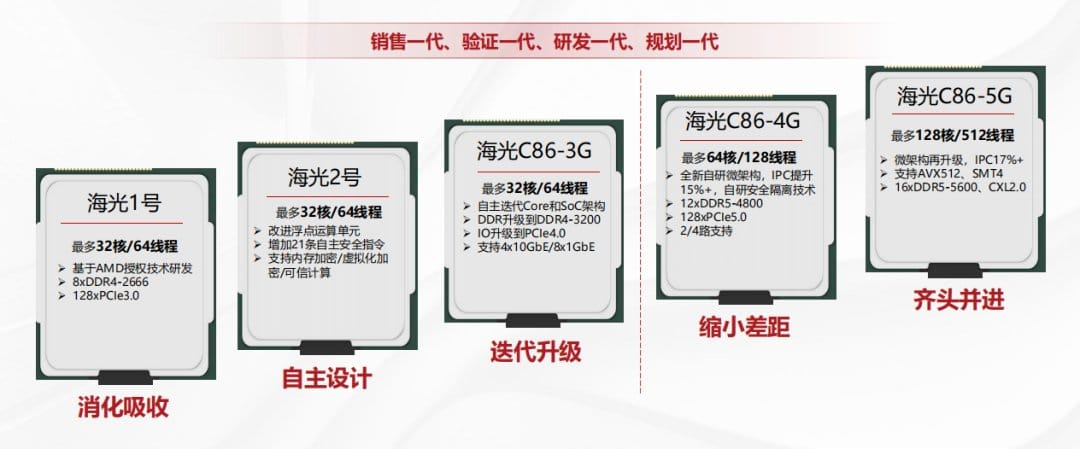The fifth generation of Hygon processors marks a new milestone in high-performance computing, with support for AVX-512, DDR5 memory, and an architecture based on AMD Zen.
The Chinese manufacturer Hygon has unveiled the details of its new CPU C86-5G, a server processor that stands out not only for its impressive number of cores—up to 128—but also for being one of the few market solutions that implement 4-way SMT, achieving a total of 512 simultaneous processing threads. This advancement positions Hygon as a key player in the infrastructure for artificial intelligence, data analytics, and enterprise virtualization market in China.
A Direct Evolution of AMD Zen Architecture
Before the wave of technology restrictions imposed by the U.S., Hygon successfully licensed the intellectual property of AMD Zen architecture, allowing it to develop its own line of x86 processors. With each iteration, the company has refined its design, culminating in this fifth generation, the most ambitious to date.
In the C86-5G, the cores show a 17% improvement in IPC (instructions per cycle) compared to its predecessor, while maintaining compatibility with the AVX-512 instruction set, essential for vector tasks, scientific calculations, and high-performance parallel workloads.
An Architecture Designed for the Future
The C86-5G is much more than a high core count. The CPU supports up to 16 channels of DDR5 memory at 5,600 MT/s, providing massive bandwidth ideal for demanding workloads. Additionally, it offers 128 PCIe 5.0 lanes, facilitating connections with graphics accelerators, high-performance NVMe drives, and network cards at extreme speeds.
It also includes support for CXL 2.0, an emerging technology that enables low-latency, high-speed communication between processors and external memories, which is key in disaggregated architectures for AI and modern data centers.
Four-Way SMT: Revolution or Challenge?
The implementation of four-way Simultaneous Multi-Threading (SMT4) is one of the most distinctive features of the C86-5G. Unlike the typical approach (two threads per core), Hygon opts for four threads per core, a technology that Intel abandoned in its latest generations due to bottlenecks in hybrid configurations. However, Hygon seems to have resolved these challenges in a homogeneous and controlled environment like servers.
An Expanding Catalog with Sovereign Vision
The C86-5G CPU is the culmination of a series of previous generations that have been gaining complexity and capabilities:
| Model | Cores | Memory | Interface | Key Features |
|---|---|---|---|---|
| C86-1G | Up to 32 / 64 threads | DDR4-2666 (8 channels) | PCIe 3.0 (128 lanes) | Initial AMD Zen license |
| C86-2G | Up to 32 / 64 threads | DDR4-2666 (8 channels) | PCIe 3.0 | Enhanced encryption and virtualization |
| C86-3G | Up to 8 / 16 threads | DDR4-3200 (4 channels) | PCIe 4.0 | First internally developed Zen 1 core |
| C86-4G | Up to 64 / 128 threads | DDR5-4800 (12 channels) | PCIe 5.0 | SP5 socket usage and multiprocessor support |
| C86-5G | Up to 128 / 512 threads | DDR5-5600 (16 channels) | PCIe 5.0 + CXL 2.0 | AVX-512, SMT4, IPC improved by 17% |
Manufactured by TSMC or SMIC?
One of the major questions surrounding this new generation is the manufacturing node used. Given the trade tensions between China and the U.S., it’s unclear whether TSMC remains the manufacturer, or if Hygon has opted for SMIC, the domestic Chinese foundry. This detail is crucial for assessing the performance, energy efficiency, and large-scale production capability of these CPUs.
In Summary
The Hygon C86-5G is presented as a cutting-edge solution that consolidates the goal of technological independence in the semiconductor sector in China. With its own x86 design, massive scalability, and cutting-edge features, this processor could play a fundamental role in the country’s data centers and in the development of large-scale artificial intelligence platforms.
While the West continues to debate supremacy between AMD, Intel, and ARM, in China, Hygon’s quiet advance demonstrates that the battle for high-performance computing is no longer just a matter for three.

